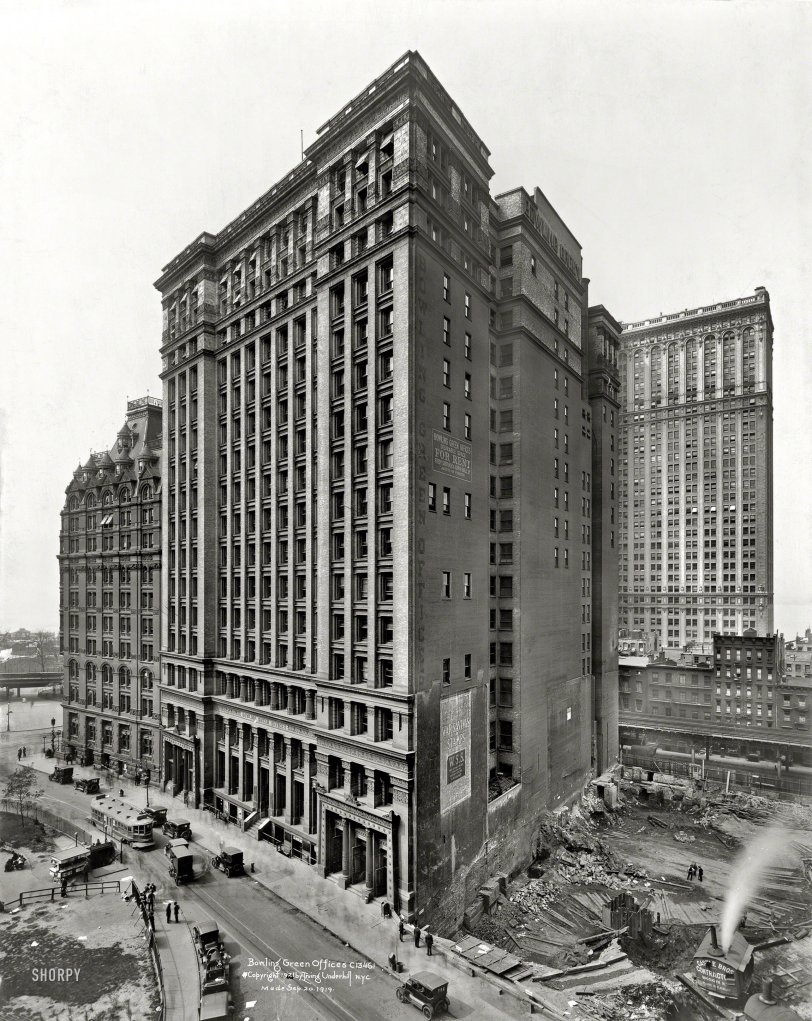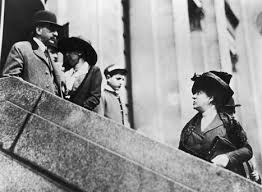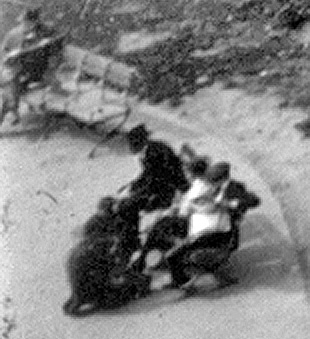


Framed or unframed, desk size to sofa size, printed by us in Arizona and Alabama since 2007. Explore now.
Shorpy is funded by you. Patreon contributors get an ad-free experience.
Learn more.

- Freeze Frame
- Texas Flyer wanted
- Just a Year Too Soon
- WWII -- Replacing men with women at the railroad crossing.
- Yes, Icing
- You kids drive me nuts!
- NOT An Easy Job
- I wonder
- Just add window boxes
- Icing Platform?
- Indiana Harbor Belt abides
- Freezing haze
- Corrections (for those who care)
- C&NW at Nelson
- Fallen Flags
- A dangerous job made worse
- Water Stop
- Passenger trains have right of way over freights?
- Coal
- Never ceases to amaze me.
- Still chuggin' (in model form)
- Great shot
- Westerly Breeze
- For the men, a trapeze
- Tickled
- Sense of loneliness ...
- 2 cents
- Charm City
- What an Outrage
- Brighton Park
Print Emporium
Bowling Green Offices: 1919

Sept. 20, 1919. "Bowling Green Offices, New York." An interesting view of a construction site next to this early skyscraper, and what might be a new Shorpy record for ghost pedestrians. Photo by Irving Underhill. View full size.
Sixth Ave. line
The elevated line in the picture is the Sixth Avenue line, on Trinity Place. The Ninth Ave line is on parallel Greenwich St, behind those low buildings along Trinity Pl. Out of sight behind the Bowling Green Building, the two lines come together, and run through Battery Park to South Ferry Station. A bit of the jointly used structure is visible at the left of the picture.
The site for the Cunard Building had been acquired by the City and cleared of older buildings, for construction of the BMT subway angling across from Trinity Place (under the IRT on Broadway) to Whitehall Street. After the subway was completed, the site was sold (with a permanent easement for the subway) and the Cunard Building built.
At the north edge of the site, 39 Broadway was the original terminal of the Metropolitan company's 6th Ave line in 1878. The tracks curved from Trinity Place into this site and ended at Broadway. The original intention of the Metropolitan had been to continue across Broadway into Beaver Street, and then turn north paralleling the Third Ave el. At that time the Metropolitan was a competitor of the NY Elevated RR, which owned the 3rd and 9th Ave lines. When the two companies merged (1880?), this terminal was abandoned and the 6th Ave line made the junction with the 9th Ave to go to South Ferry. The company probably sold the Broadway frontage of the old terminal site, but retained a piece on the Trinity Place side, which was used for a terminal for a package express operation of the el. A siding from the 6th Ave line went into the top floor of this building. This would have been one of the buildings cleared for the subway construction.
Hudson Terminal was several blocks to the right, out of the picture. (Two stops further uptown on the IRT, the BMT and the 6th Ave el).
What's the name again?
Are you sure it's the Bowling Green Offices building? I'm just not positive, there are *only* four signs that say so...
On a side note, the construction site next door reminds me of one of my favorite childhood stores, "Mike Mulligan and his Steam Shovel."
Wrong Direction
The building to the left is 17 Battery Place, still standing, though the roof has been altered. # 1 Broadway is not in the frame, and it would be to the right of this building.
[17 Battery Place is around the corner and two blocks down. -tterrace]
Aha - the subway entrance threw me. I thought I had Battery Park not Bowling Green Park before me.
Mea Culpa.
Castle Brothers steam shovels
Castle Brothers Contractors built Ebbets Field, home of the Brooklyn Dodgers. Today we would call that "local sourcing."
One Broadway
I had read elsewhere that the current 1 Broadway (the building to the left of the Bowling Green Building) was not built as a new building in the early 1920's, but rather had a limestone facade installed over the extant brick. Discussed in more detail in this post at ScoutingNY.
Still no exorcism?
By 1919, one would think, advances in shutter mechanisms and the availability of faster films should have eliminated the ghost pedestrian effect without unacceptable sacrifice of resolution, unless, of course, this was taken with a humongous view camera and plates.
[It was exposed on a glass plate in a view camera, plus a small lens aperture would have been used to maximize sharpness and depth of field; all contribute to the necessity of a longer exposure time. -tterrace]
White Star Line
was located up the steps in the center of the building. Mrs. Benjamin Guggenheim called at the White Star Line to get status of her husband following the sinking of RMS Titanic April 1912.

Cunard Building
The building shown in the very early stages of construction in this photo became the Cunard Building, named after the famous steamship line. In those pre-Travelocity days the usual way to book travel on one of the grand ocean liners like the original Queen Elizabeth or Queen Mary was by going to the enormous ticketing hall located in the building's lobby. Other shipping lines and transportation-related companies rented space in the building.
Cunard moved out of the building in the late 1960's, and much of the structure actually was vacant for many years. The grand lobby hall became a post office several years later, and the building now houses a variety of tenants. It is located directly across the street from the famous Charging Bull statue.
Note the painted signs on the side of the Bowling Green Building. They were lost to view when the Cunard Building went up, but chances are very good that they are still there, and still readable thanks to being protected from sunlight. If someday the Cunard Building is demolished while the Bowling Green Building still stands, the signs will (literally) come back to light. It has happened before: http://forgotten-ny.com/1998/05/keals-carriage-manufactory/
On both the right and left sides of the photo you can see an elevated train line. That's the Ninth Avenue El, which ran along Greenwich Street in lower Manhattan, one block west of Broadway. It closed around 1940 and the structure came down soon afterward. On the left of the picture there is a subway entrance in Bowling Green, serving the IRT subway line. There is no longer an entrance at that location.
Fascinating
The street life and vehicles are really interesting. The lighting well in the near side of the Bowling Green Buildings shows what you would get for air circulation in the interior offices in the days before a/c, and even into the 1960's. Note the awnings on the windows in the background.
A demolition site
At this point, as the city begins to rise from the ground. Are those buildings across the street shuddering with fear?
Still there!
And still quite a grand piece of architecture:
Gambling?
Is that group of men in the park to the left of the news-stand playing dice?
[I'm guessing some shoe-shining going on. -tterrace]

























On Shorpy:
Today’s Top 5